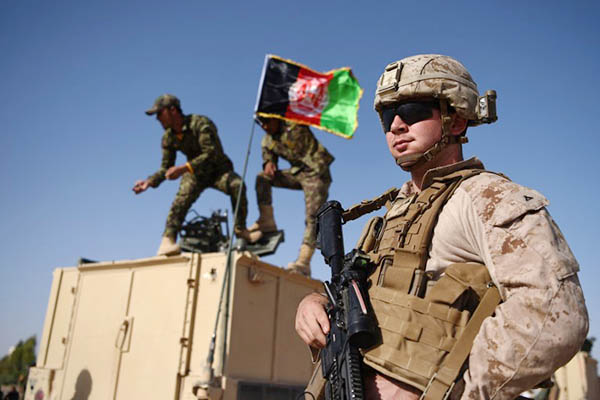
File photo. Wakil Kohsar—AFP
Analysts warn militant groups such as Al Qaeda and Islamic State need constant pressure
The United States is negotiating its withdrawal from Afghanistan with the Taliban but after 18 years, several thousand U.S. personnel could remain to prevent the Islamic State group and Al Qaeda from using the country as a base for staging global attacks.
The negotiations aim to bring an end to fighting against the Taliban, who controlled the country when Al Qaeda, based in the southern city of Kandahar, attacked the United States on September 11, 2001. Still protected by the Taliban, Al Qaeda remains active in parts of Afghanistan, complemented by jihadists from I.S., and Washington experts say pressure has to be maintained on them through an ongoing U.S. counter-terrorism presence.
“The Taliban at the end of the day wants the entire U.S. military footprint to disappear,” said Michael Kugelman, senior associate for South Asia at the Wilson Center think tank. However, he said, the U.S. needs to continue pressuring Islamic State and Al Qaeda from inside the country “just as, if not more, robustly as it has been tackling it over the previous years.”
“You certainly don’t need a huge a military footprint to tackle the current terror threat in Afghanistan,” he said. “You need at least a few thousand. A lot of it depends on the capacity of the Afghan security forces.”
The first outlines of an agreement under negotiation in Qatar have Washington reducing its current 13-14,000 troop levels to 8,600, and completely exiting five bases, over 135 days. That would be contingent on the Taliban meeting their commitment to reducing the level of violence—basically halting their attacks on U.S. and Afghan government targets.
Further drawdowns would depend on negotiations between the Afghan government and the Taliban. But General Joseph Dunford, Chairman of the Joint Chiefs of Staff, said last week that not every American would leave, because of the ongoing threat from designated terror groups operating in Afghanistan.
“I’m not using the ‘withdrawal’ word right now,” Dunford said. “I’m using, we’re going to make sure that Afghanistan is not a sanctuary, and we’re going to try to have an effort to bring peace and stability to Afghanistan.”
Trump came into office promising a full withdrawal from the seemingly unending wars in the Middle East and South Asia. But the reality is that groups like Al Qaeda and I.S., which is also known as ISIS and has a potent branch in Afghanistan, require constant pressure.
How much pressure depends a lot on the strength of Afghan government forces and whether the Taliban are willing to give up their support for Al Qaeda and even cooperate in fighting Islamic State, said Kugelman. “The biggest terrorism threat in Afghanistan right now is ISIS,” he said, describing Al Qaeda as “a shadow of its former self.”
One key worry, he said, is whether Taliban hardliners who disagree with striking a deal with the United States and the Kabul government, will defect to join I.S. Still, he added, “I really don’t see ISIS posing the global threat that you had with Al Qaeda back in the 1990s. There are too many constraints.”
Former U.S. ambassadors to Afghanistan on Tuesday sounded their own warning against a full withdrawal. “While some reduction of troop numbers is possible to start negotiations, counterterrorism forces and U.S./NATO airpower need to remain to deal with the terrorist threat of I.S. [and Al Qaeda] as much as the Taliban,” they said in a joint statement.
A post-deal U.S. security presence in Afghanistan would mean less uniformed regular military troops and more focus on special forces, CIA paramilitary units, intelligence collectors and analysts, and air support.
Michael O’Hanlon, a senior fellow at the Brookings Institution, suggests that the U.S. and allies could still need to have 3,000 to 6,000 people on the ground, dispersed based on the location of threats, surveillance demands and air support operations. “I think that three or four large bases [Bagram, Kandahar, ideally Khost and Jalalabad, with some allied capability up north and west] would roughly do it,” he told AFP in an email. “If you think of 1,000 to 1,500 people per base in rough numbers that gives a sense of the needed scale,” he said.

3 comments
Contrary to common misconception, the Taliban hates Pakistan for allowing NATO to use it as a supply route for NATO’s occupation of Afghanistan (that is why the TTP was created in 2006 in the first place). The Taliban will get their revenge by invading and conquering Pakistan and by bringing all the murtad puppet Zionist traitors within it to justice.
The Taliban will win THIS YEAR. The Taliban will kill all of the Afghan presidential election candidates, including Ghani, THIS MONTH. The Taliban will kick out all the NATO invaders/occupiers from Afghanistan, liberate all of Afghanistan, and win THIS YEAR. One of the Taliban’s red lines is that there is no Afghan presidential election, and they have vowed to prevent that from happening.
OBL said he did 9/11 because of the Israeli occupation of Palestine.